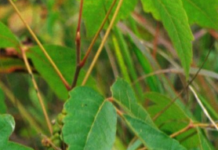By: Scott Eckert, Harvey County Extension Agent
The abundance of elm and silver maple seeds produced this spring is going to create some unwanted tree situations in our landscapes. Though trees are a vital part of our landscapes, there are situations where volunteer trees need to be controlled. This is often a case of the wrong plant in the wrong place. If the tree is still small and a desirable species, you may want to consider transplanting in the spring. If it is not, active control measures would be in order.
Most, but not all, trees re-sprout after cutting. Cutting those that don’t re-sprout is an effective control method. For example, eastern redcedar is a very common species that will not re-sprout after cutting. Those that do re-sprout include Siberian elm, hackberry, Osage orange (hedgeball), oak, ash, aspen, cottonwood, maple, sycamore, willow and many more. These trees will either need to be dug out or the stump treated with herbicide after cutting.
Note that when we say volunteer trees, we mean those that come from seed rather than suckers that originate from the roots of an existing tree. The recommendations given in the remainder of this guide sheet are designed to kill these volunteer trees. Using herbicides on suckers will damage and very possibly kill the original tree. Trees that commonly produce suckers include tree of heaven, honeylocust, black locust, hackberry, western soapberry, cottonwood, aspen, poplar, willow and boxelder.
It is also possible for larger trees of the same species to be root-grafted. Even though root-grafted trees are not suckers, they do share materials between the individual root systems and therefore herbicides used to treat one tree can be passed to its neighbor. Let’s say we have a tree we want to control that is a volunteer and there are no other trees of the same species close enough to be root-grafted that we do not wish to harm. What do we do? If the tree is any size, you probably do not want to dig it out. Most commonly, that leaves using an herbicide on the cut stump.
Triclopyr is the active ingredient in herbicides for woody plant control most commonly available to homeowners. Triclopyr is found in many brush killers but few have directions for a cut stump treatment.
Fertilome Brush Killer Stump Killer is one that does. Read the label that is on other products before purchasing to make sure that a cut stump treatment is listed. Most often the undiluted product is applied to the stump immediately after cutting. Commercial products with triclopyr include Remedy and Pathfinder II. These products are mixed with diesel or kerosene before treatment. A paint brush can be used for the application. It is important that the stump is treated immediately or at least within 5 minutes. Note that a paint brush with foam rather than bristles is less likely to drip. If you have a number of trees that need to be treated, you may want to invest in a cut stump applicator such as the Buckthorn Blaster.
Trees do not need to be actively growing to be controlled. Best control is often achieved between mid-July and mid-January.




